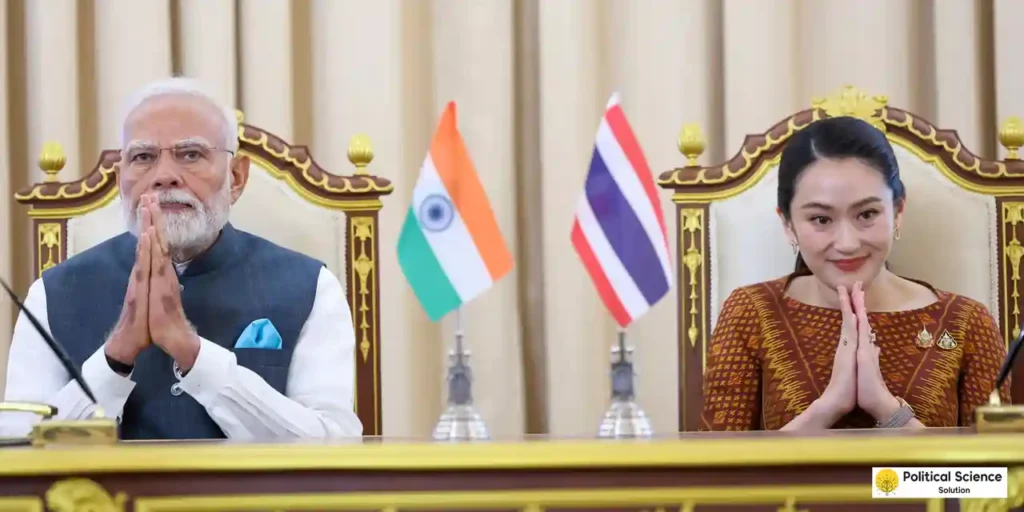New Delhi: In a landmark move that signals a deepening of ties between two vibrant Indo-Pacific nations, India and Thailand have officially inked a Joint Declaration to establish a Strategic Partnership. This historic agreement, signed during a high-profile meeting between Indian Prime Minister Narendra Modi and Thai Prime Minister Paetongtarn Shinawatra in Bangkok on April 5, 2025, marks a significant milestone in bilateral relations that have been steadily evolving since diplomatic ties were first established in 1947. With a focus on security, trade, technology, and cultural exchange, this partnership is poised to reshape regional dynamics and foster mutual growth in an increasingly interconnected world.

The Genesis of a Strategic Alliance
The concept of a strategic partnership, though less formal than a military alliance, is rooted in a shared vision for cooperation across multiple domains. For India and Thailand, this vision encompasses a commitment to a free, open, transparent, rules-based, inclusive, and resilient Indo-Pacific region. Both nations have underscored their support for ASEAN Centrality, recognizing the Association of Southeast Asian Nations (ASEAN) as a pivotal force in shaping the geopolitics and geo-economics of the region. This alignment is particularly significant given Thailand’s role as a maritime neighbor to India and a key player in maintaining regional peace.
The timing of this partnership is no coincidence. As global power dynamics shift and the Indo-Pacific emerges as a critical theater of influence, India’s “Act East” policy and Thailand’s complementary “Act West” policy have found a natural synergy. This convergence has paved the way for a robust framework that promises to deliver tangible benefits for both nations while amplifying their collective voice in regional and sub-regional groupings like ASEAN, the Bay of Bengal Initiative for Multi-Sectoral Technical and Economic Cooperation (BIMSTEC), and the Mekong Ganga Cooperation initiative.
Key Agreements: Building Blocks of Collaboration
The Joint Declaration was accompanied by the signing of six pivotal Memoranda of Understanding (MoUs), each targeting a specific area of cooperation. These agreements reflect the multifaceted nature of the India-Thailand relationship and highlight the depth of their commitment to mutual progress.
- Digital Technology Cooperation: A flagship MoU between India’s Ministry of Electronics and Information Technology and Thailand’s Ministry of Digital Economy and Society aims to bolster collaboration in the digital realm. With a focus on cybersecurity, digital skilling, and emerging technologies, this agreement positions both nations to capitalize on the global digital revolution. Joint training programs, knowledge-sharing initiatives, and the development of regulatory frameworks are expected to drive innovation and enhance interoperability in their digital ecosystems.
- National Maritime Heritage Complex (NMHC) at Lothal: A cultural milestone, this MoU between India’s Sagarmala Division (Ministry of Ports, Shipping and Waterways) and Thailand’s Fine Arts Department (Ministry of Culture) will support the development of the NMHC in Lothal, Gujarat. This project aims to celebrate India’s rich maritime history while fostering a shared narrative with Southeast Asia. The partnership will facilitate the exchange of preservation techniques, historical research, and expertise, positioning Lothal as a global hub for maritime heritage.
- Development of India’s North Eastern Region: Recognizing Thailand’s strategic proximity to India’s northeastern states, this agreement seeks to enhance connectivity and economic development in the region. Projects like the India-Myanmar-Thailand Trilateral Highway are expected to gain momentum, unlocking new trade corridors and strengthening ties with ASEAN.
- India-Thailand Consular Dialogue: To boost people-to-people contact, both nations have agreed to establish a consular dialogue framework. This initiative will streamline visa processes, promote tourism, and facilitate cultural exchanges, further cementing the human connection between the two countries.
- Local Currency Settlement Mechanism: In a bid to enhance trade facilitation, India and Thailand are exploring the establishment of a local currency-based settlement system. By reducing dependence on third-party currencies like the US dollar, this mechanism could lower transaction costs and boost bilateral trade, which already reached approximately USD 15 billion in 2023-24.
- Defence and Security Cooperation: Building on existing military exercises like MAITREE and INDO-THAI CORPAT, this agreement reaffirms the commitment to deepen defence ties. It includes provisions for intelligence sharing and counter-terrorism efforts, addressing shared threats posed by non-state actors, terrorists, and traffickers in the region.
Historical Context: A Relationship Rooted in Resilience
India and Thailand’s diplomatic journey began in 1947, shortly after India’s independence, laying the foundation for a relationship that has weathered geopolitical shifts and economic challenges. Over the decades, the two nations have cultivated a partnership that spans economic, cultural, and strategic spheres. Bilateral trade has grown steadily, reaching USD 15 billion in the 2023-24 fiscal year, while defence cooperation has been reinforced through joint exercises and high-level exchanges.
A notable precursor to the 2025 Strategic Partnership came in January 2012, when then-Indian Prime Minister Manmohan Singh and Thai Prime Minister Yingluck Shinawatra signed six accords covering defence, security, and economic cooperation. That meeting, held in New Delhi, set the stage for elevating ties to a strategic level, with both leaders emphasizing the need to counter terrorism and enhance regional stability. The 2025 agreements build on this legacy, adapting to contemporary challenges like digital transformation and maritime heritage preservation.
Strategic Significance: A Regional Power Play
The India-Thailand Strategic Partnership is more than a bilateral arrangement—it’s a statement of intent in a rapidly evolving Indo-Pacific landscape. Thailand’s geographic position as India’s maritime neighbor and its influence within ASEAN make it a critical partner in India’s regional ambitions. Conversely, India’s growing stature as an economic and military power offers Thailand a reliable ally in navigating the complexities of Southeast Asian geopolitics.
Both nations share a vested interest in countering the rise of non-state actors, including terrorists, drug traffickers, and arms smugglers, who exploit the region’s porous borders. During their Bangkok meeting, Modi and Shinawatra condemned terrorism in all its forms, stressing the urgency of a five-year Joint Working Programme to address these threats through enhanced security and intelligence cooperation. This resolve echoes their 2012 commitment to establish a bilateral legal framework to tackle subversive elements—a goal that has now been partially realized with the Agreement on Transfer of Sentenced Persons.
Economic and Cultural Dividends
Economically, the partnership promises to unlock new avenues for growth. The exploration of a local currency settlement mechanism could revolutionize trade by making transactions more efficient and cost-effective. Meanwhile, the focus on connectivity—exemplified by the Trilateral Highway project—will link India’s northeastern states to Thailand via Myanmar, fostering trade, tourism, and investment.
Culturally, the NMHC collaboration and the consular dialogue underscore the importance of shared heritage and people-to-people ties. Thailand’s support for India’s bid for a permanent seat at the United Nations Security Council (UNSC), reiterated by Shinawatra in Bangkok, further cements their mutual respect and aligned global aspirations.
The Road Ahead: Challenges and Opportunities
While the Strategic Partnership heralds a new chapter, it is not without challenges. Coordinating policies across diverse sectors like digital technology and maritime heritage requires sustained effort and investment. Regional tensions, including those involving Myanmar—a key link in the Trilateral Highway—could also complicate connectivity initiatives. Moreover, both nations must navigate the delicate balance of maintaining ASEAN Centrality while pursuing their bilateral goals.
Yet, the opportunities far outweigh the hurdles. By leveraging their complementary strengths—India’s technological prowess and Thailand’s regional influence—the partnership could serve as a model for Indo-Pacific cooperation. The emphasis on emerging technologies like cybersecurity and digital skilling aligns with global trends, positioning both countries as leaders in the digital age.
Conclusion: A Partnership for the Future
The India-Thailand Strategic Partnership, formalized on April 5, 2025, is a testament to the enduring bond between two nations united by history, geography, and ambition. From digital innovation to maritime heritage, defence to trade, this alliance spans the spectrum of modern diplomacy, offering a blueprint for regional collaboration. As Modi and Shinawatra chart this bold new course, the world watches a partnership that promises not just mutual benefit, but a stronger, more resilient Indo-Pacific.
FAQs
1. What is the India-Thailand Strategic Partnership?
Answer: The India-Thailand Strategic Partnership is a formal agreement signed on April 5, 2025, between Indian Prime Minister Narendra Modi and Thai Prime Minister Paetongtarn Shinawatra in Bangkok. It elevates bilateral relations to a new level, focusing on cooperation in security, trade, technology, and cultural exchange. The partnership aims to promote a free, open, and resilient Indo-Pacific region while supporting shared goals like ASEAN Centrality and regional stability.
2. What are the key agreements signed between India and Thailand in 2025?
Answer: In 2025, India and Thailand signed six key Memoranda of Understanding (MoUs). These include cooperation in digital technologies (cybersecurity and digital skilling), the development of the National Maritime Heritage Complex (NMHC) at Lothal, Gujarat, the development of India’s North Eastern Region, the establishment of an India-Thailand Consular Dialogue, exploration of a local currency settlement mechanism for trade, and enhanced defence and security collaboration.
3. How does the Strategic Partnership benefit India and Thailand?
Answer: The partnership benefits both nations by strengthening security through joint counter-terrorism efforts and intelligence sharing, boosting trade (already at USD 15 billion in 2023-24) with initiatives like local currency settlements, and enhancing connectivity via projects like the India-Myanmar-Thailand Trilateral Highway. It also fosters cultural ties through the NMHC project and promotes technological innovation, aligning with India’s “Act East” and Thailand’s “Act West” policies.
4. Why is ASEAN Centrality important in the India-Thailand relationship?
Answer: ASEAN Centrality refers to the pivotal role of the Association of Southeast Asian Nations (ASEAN) in shaping regional geopolitics and economics. Both India and Thailand support this principle, with Thailand as a key ASEAN member and India as a partner. This shared stance strengthens their collaboration in regional forums like BIMSTEC and the East Asia Summit, ensuring a unified approach to Indo-Pacific challenges.
5. What role does the National Maritime Heritage Complex (NMHC) play in this partnership?
Answer: The NMHC at Lothal, Gujarat, is a joint project under an MoU between India’s Sagarmala Division and Thailand’s Fine Arts Department. It aims to preserve and promote maritime heritage, linking India’s historical trade routes with Southeast Asia. The collaboration involves sharing preservation techniques and historical research, boosting cultural ties and positioning Lothal as a global maritime heritage hub.

